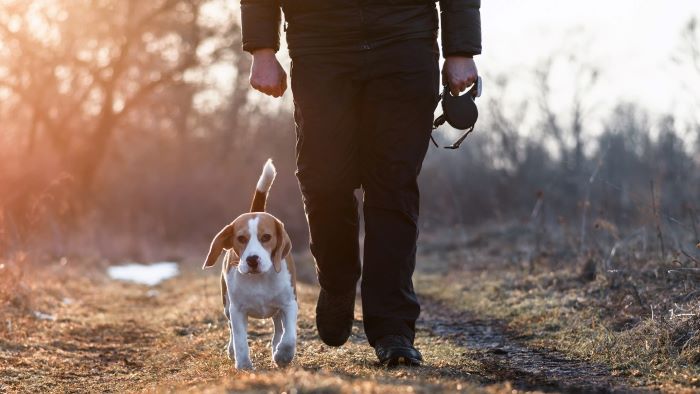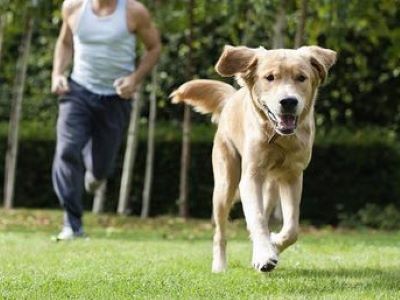You must have practised walking with your dog on a loose leash and now you are tempted for off-leash training, right? Well, many pet owners want their dogs to walk or play freely around them. For that, they also train their dog to walk politely on a leash.

But, do you really think that your dog won’t run away from you? Thus, the question arises when to let the dog off the lead. Is loose leash training enough to let your dog off-leash or do you need some other training too? Let us explore!
When Your Dog is On-Leash
Before letting your dog off-leash, you need to make sure that the dog is well-behaved while walking on the leash. Thus, you should train them not to pull on the lead. Moreover, they should not jump or bark on triggers like other dogs, people around or objects.
“While he’s on his way to you, still wearing the leash and collar, back up a few paces and then reward him when he gets to you. Continue the progression until your puppy, upon hearing the cue noise, comes to you“, advises Kathy Santo from the American Kennel Club.
When the dog is off-leash, it must be still under your control. They can also explore places that you want as well as come to you when called. For this, the dog should be trained to follow commands like ‘sit‘, ‘stand‘, ‘come‘, ‘heel‘ and ‘leave it‘.
When to Let the Dog Off the Lead?
You may want to let your dog explore the surrounding off-leash. You may think of giving this little freedom to your dog. But, is your dog trained enough to return to you? When to let the dog off the lead?
Well, many believe that once the dog is leash-trained properly, he can be left off-leash. But wait! What about obeying your commands? Have you ever thought of that? Here, are the ways by which you can ensure that the dog is ready to go off-leash.
1) Responding to Various Commands
Firstly, the dog must respond to your verbal cues. You should train your dog for commands like ‘sit’, ‘stand’, ‘go’ and most importantly, ‘come’. This is because the dog should come to you when called.
Dogs are domesticated animals and many breeds have wild instincts. They may escape in search of any prey and never return even when called. Thus, your dog should listen to you even in crowded places, full of distractions to ensure that they obey you no matter what!

Other than these commands, ‘leave it’ or ‘drop it’ is another crucial command to teach your dog. Think of your dog off-leash and he tries to grab something from the ground. Yes, that is where the command comes into the picture. The object on the ground can be full of bacteria which can harm the dog when ingested.
2) Taking Advantage of the Freedom
The best to know how your dog reacts when offered freedom is to use a retractable lead. It can let your dog explore giving a little more freedom while under control. If he behaves properly on a retractable lead; does not jump or bark, does not ask for more loose lead, comes to you on command and sniffs around only at safe places, then you might consider letting him off-leash.
You can allow a little more freedom while maintaining control by using a best double ended dog lead. This type of lead allows your dog to explore while you maintain control
A dog walking off-leash on the road can be a threat to people around. He might bite or jump on someone or get triggered by other dogs or objects. Thus, it is necessary to train your dog to behave properly around others.[1]
3) Spayed or Neutered Dog
Intact dogs often have strong desires to roam and mate with another dog. This is their natural instinct. But, you don’t want that to happen as it can lead to trouble and can worsen the situation. Spaying or neutering your dog can reduce this urge and also prevent unwanted pregnancies and health problems.
4) Vaccination
Being off-leash exposes your dog to more risks of getting infected by diseases or parasites from other animals or the environment. You need to protect your dog from these threats by keeping their vaccinations up-to-date and applying flea and tick preventatives regularly.[2]

Vaccinations protect your pet from several highly contagious diseases such as canine distemper, parvovirus infection and respiratory tract infections. It also protects against transmissible diseases such as rabies that also pose a risk to humans. Thus, by vaccinating the dog, you keep him as well as others around him safe.
5) Choosing the Right Place
You need to choose the right time and place to let your dog off-leash. Not every time and place is suitable for letting your dog off leash. You need to avoid busy streets, traffic, livestock, wildlife, other dogs on lead, extreme weather, etc.
These situations can pose dangers or challenges for your dog or others. You need to find a safe and appropriate place where you can let your dog off leash without causing any harm or disturbance. Ideally, this place should be fenced-off, enclosed, quiet, familiar and dog-friendly.
Benefits of Allowing Your Dog to Off Leash
Letting your dog off the lead can have many benefits for both you and your dog, such as:
- It provides your dog with more exercise and mental stimulation. Being off-leash allows your dog to run, play, explore, sniff, chase and do whatever they enjoy doing. This can help them burn off excess energy, reduce boredom, relieve stress and improve their physical and mental health.
- It strengthens your bond with your dog. Being off-leash gives your dog more freedom and choice, which can make them happier and more confident. It also shows your trust and respect for your dog, which can enhance your relationship with them. Moreover gives you an opportunity to interact with your dog, such as playing games, teaching tricks or just having fun together.
- It improves your dog’s social skills. Being off-leash exposes your dog to more social situations with other dogs and people. This can help them learn how to communicate, behave, and cooperate with others. It can also help them make new friends and have positive experiences.
Risks of Allowing Your Dog Off Leash
Letting your dog off the lead can also have some risks for both you and your dog, such as:
- It exposes your dog to more dangers and hazards. Being off-leash increases the chances of your dog getting injured, lost, or stolen. Your dog may encounter harmful objects or substances, such as sharp rocks, glass, trash, poison, etc. Your dog may also run into traffic or get trapped in fences or holes.
- It causes trouble or nuisance for others. Being off-leash may make your dog act inappropriately or irresponsibly towards other dogs or people. Your dog may jump on, bark at, chase, bite, or fight with others. Your dog may also damage or destroy the property or belongings of others. Your dog may also poop or pee where they are not supposed to.
- It breaks the law or rules. Being off-leash may violate the local leash laws or rules that are in place for the safety and welfare of everyone. You may face fines or penalties for letting your dog off-leash where it is not allowed or permitted. You may also be held liable for any damage or harm that your dog causes while off-leash.
Letting your unleashed dog approach other dogs on a leash can cause trouble. For safety, learn how to hold a dog lead in a way that keeps your dog under control
What to Do If Your Dog Starts to Run Away?
One of the worst scenarios that can happen when you let your dog off the lead is that they start to run away from you and do not come back when you call them. This can be a terrifying and stressful situation for both you and your dog.

Do not panic. Panicking will only make things worse and make you lose control of yourself and the situation. Stay calm and composed and try to think rationally and logically.
Do not chase. Chasing will only make your dog run faster and farther away from you. It will also make them think that you are playing a game with them or you are angry with them. Instead of chasing, try to get their attention by calling their name, using a whistle or a toy or making a funny noise.
Do not scold. Scolding will only make your dog afraid of you and less likely to come ome back to you. It will also damage your relationship with them and make them lose trust in you. Instead of scolding, praise them when they come back to you or when they look at you.
Do not give up. Giving up will only make you lose hope and miss opportunities to get your dog back. Keep trying until you find your dog or get help from someone else.
Do get help. Getting help will increase your chances of finding your dog and bringing them back safely. You can ask other people nearby to help you look for your dog or to call you if they see them. You can also contact local shelters, vets, or animal control to report your missing dog and to check if they have found it.
FAQs
Should I just let my dog off the lead?
You should only ever let your dog off leash in open areas away from roads and busy public places. It’s a good idea to remain respectful of other people and letting your dog off the lead shouldn’t concern or bother others.
Will my dog come back if I let him off the lead?
A dog will come back so long as they don’t get lost or have some kind of accident that prevents their return. If your dog runs away and makes it back to you without serious incident, this is the best-case scenario.
How do I teach my dog to come when called?
Start your training in a slow, low-distraction environment. First, show your dog a toy or a tasty treat and praise them as they are coming to you. After a few repetitions, whenever your dog looks at you and starts to move towards you, add in your chosen verbal cue (“come,” “here,” etc.). Make sure to only add in the cue when you are confident your dog is moving towards you.
How do I trust my dog off the lead?
Whenever you are out with your dog off-leash, practice regular, automatic check-ins with your pup. Call them to your side every few minutes and reward them with a treat or ‘good dog’. Continually reinforce this habit so you’ll be ready for any situation.
Final Thought
Letting your dog off the lead can be a wonderful experience for both you and your dog, but it also comes with some risks and responsibilities that you need to be aware of and prepared for. You need to make sure that your dog is ready and suitable for off-leash walking.
You also need to train your dog to be reliable off the lead and to come back when called. Moreover, you need to be prepared for any emergencies or challenges that may arise when you let your dog off the lead.
Hope you will be able to enjoy walking your dog off the lead safely and responsibly. Remember that every dog is different and that you may need to adjust your approach according to your dog’s needs and personality.
If your dog is prone to biting or chewing their leash, be sure to address this behavior through training before attempting off-leash walking. Understanding why dogs bite the leash when walking is key to correcting the issue.
References:
- Taylor Fabus, Michigan State University Extension, Juliana Forbush, MSU Extension Student Intern. (2014). How to keep your pet friendly. MSU Extension from Michigan State University.
- Tarantino, M., DVM. (2023). Puppy and dog vaccinations: a schedule for every life stage. PetMD.



